Aprilia SONIC 50 1998 Manual
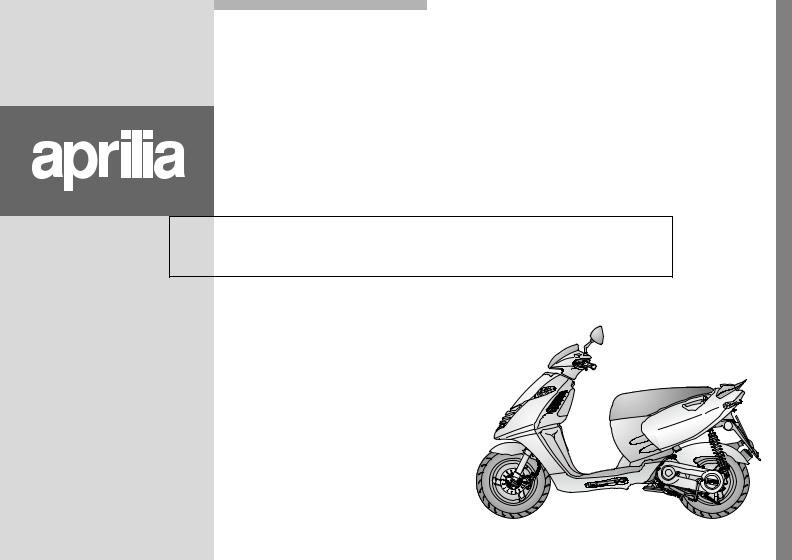
use and maintenance
aprilia part# 8202105 |
Sonic 50 |

© 1998 aprilia s.p.a. - Noale (VE)
This manual is to be considered an integral part of the vehicle, which must be delivered complete with it also in case of resale.
aprilia s.p.a. reserves the right to modify its models at any time, without prejudice to the main characteristics here described.
All rights as to electronic storage, reproduction and total or partial adaptation, with any means, are reserved for all Countries.
The mention to products or services supplied by third parties is made only for information purposes and is not binding in any case.
aprilia s.p.a takes no responsibility as to the performance or the use of said products.
First edition: january 1998
Reprint: march 1998
Produced and printed by:
Studio Tecno Public
Viale del Progresso - 37038 Soave (VR) - Italy
Tel. +39 (0)45 -76 11 911
Fax +39 (0)45 -76 12 241
www.stp.it
E-mail: customer@stp.it
On behalf of: aprilia s.p.a.
via G. Galilei, 1 - 30033 Noale (VE) - Italy Tel. +39 (0)41 - 58 29 111
Fax +39 (0)41 - 44 10 54 www.aprilia.com
2 use and maintenance Sonic 50

FOREWORD
Before starting the engine, carefully read this manual, paying particular attention to the chapter "RIDING SAFELY".
Your and other people’s safety depends not only on your quickness of reflexes and on your agility, but also on what you know about the vehicle, on its efficiency and on your knowledge of the basic information for RIDING SAFELY.
Therefore, get a thorough knowledge of the vehicle, in such a way as to be able to drive in the traffic safely.
For the controls and repairs not expressly described in this manual, for the purchase of aprilia Genuine Spare Parts, accessories and other products, as well as for specific technical advice, contact only aprilia Authorized Outlets and Official Dealers, who can ensure you reliable and prompt servicing.
Thank you for choosing aprilia. We wish you a nice ride.
IMPORTANT:
When asking your Dealer for spare parts, specify the spare parts code indicated on the SPARE PARTS IDENTIFICATION LABEL. Write down the identification code in the space here below, in order to remember it also in case of loss or deterioration of the label.
The label is positioned on the right beam of the frame; to read it, remove the inspection cover, see p. 50 (REMOVING THE INSPECTION COVER).
aprilia CODICE RICAMBI spare parts code number
N˚ |
|
|
I.M. |
A |
B |
C |
D |
E |
|
|
|
|
|
|
|
||
|
|
|
|
|
|
|
|
|
|
|
|
|
|
|
|
|
|
I |
UK |
A |
P |
SF |
B |
D |
F |
E |
|
|
|
|
|
|
|
|
|
GR |
NL |
CH |
DK |
J |
SGP |
PL |
IL |
ROK |
|
|
|
|
|
|
|
|
|
MAL |
RCH |
BM |
USA |
AUS |
|
|
|
|
|
|
|
|
|
|
|
|
|
Carefully observe the instructions preceded by the following warning signs:
aSafety norms and regulations to protect the driver and other people from severe injuries or grave risks.
Indications to make the operations easier. Technical information.
The operations preceded by this symbol must be repeated on the opposite side of the vehicle.
In this manual the various versions are indicated by the following symbols:
_ automatic light switching version (Automatic Switch-on Device)
& optional |
|
1 liquid-cooled version |
|
2 catalytic version |
|
I Italy version |
£ Denmark version |
U United Kingdom version |
J Japan version |
A Austria version |
S Singapore version |
P Portugal version |
V Poland version |
" Finland version |
% Israel version |
B Belgium version |
K South Korea version |
D Germany version |
M Malaysia version |
F France version |
R Chile version |
E Spain version |
Q Bermuda version |
G Greece version |
- United States of America version |
O Holland version |
^ Australia version |
C Switzerland version |
|
use and maintenance Sonic 50 |
3 |

TABLE OF CONTENTS |
|
SAFE DRIVE ............................................................... |
5 |
BASIC SAFETY RULES ...................................... |
6 |
CLOTHING .......................................................... |
9 |
ACCESSORIES ................................................. |
10 |
LOAD ................................................................. |
10 |
ARRANGEMENT OF THE MAIN ELEMENTS ........ |
12 |
ARRANGEMENT OF THE INSTRUMENTS ............ |
14 |
INSTRUMENTS AND INDICATORS ........................ |
14 |
INSTRUMENT AND INDICATOR TABLE ......... |
15 |
MAIN INDEPENDENT CONTROLS ......................... |
16 |
CONTROLS ON THE LEFT SIDE |
|
OF THE HANDLEBAR ...................................... |
16 |
CONTROLS ON THE RIGHT SIDE |
|
OF THE HANDLEBAR ...................................... |
17 |
IGNITION SWITCH ........................................... |
18 |
STEERING LOCK ............................................. |
18 |
AUXILIARY EQUIPMENT ........................................ |
19 |
UNLOCKING/LOCKING THE SADDLE ............ |
19 |
CRASH HELMET / GLOVE COMPARTMENT .. |
19 |
ANTI-THEFT HOOK .......................................... |
19 |
TOOL KIT .......................................................... |
20 |
BAG HOOK ....................................................... |
20 |
GLOVE COMPARTMENT ................................. |
20 |
MAIN COMPONENTS .............................................. |
21 |
FUEL ................................................................. |
21 |
2 STROKE OIL TANK ....................................... |
22 |
BRAKE FLUID - recommendations ................... |
22 |
FRONT BRAKE DISC ....................................... |
23 |
REAR DRUM BRAKE ........................................ |
24 |
TYRES ............................................................... |
25 |
COOLANT 1 .................................................. |
26 |
AUTOMATIC |
|
LIGHT SWITCHING VERSION _ .................. |
28 |
CATALYTIC SILENCER 2............................. |
28 |
INSTRUCTIONS FOR USE ...................................... |
29 |
PRELIMINARY CHECKING OPERATIONS ...... |
29 |
STARTING ........................................................ |
30 |
DEPARTURE AND DRIVE ................................ |
32 |
RUNNING-IN ..................................................... |
33 |
STOPPING ........................................................ |
33 |
PARKING .......................................................... |
33 |
POSITIONING THE VEHICLE |
|
ON THE STAND ................................................ |
34 |
SUGGESTIONS TO PREVENT THEFT ............ |
34 |
MAINTENANCE ....................................................... |
35 |
REGULAR SERVICE INTERVALS CHART ...... |
35 |
IDENTIFICATION DATA ................................... |
36 |
AIR CLEANER ................................................... |
37 |
CHECKING |
|
THE TRANSMISSION OIL LEVEL .................... |
38 |
CHANGING |
|
THE TRANSMISSION OIL ................................ |
39 |
FRONT WHEEL ................................................ |
40 |
REAR WHEEL ................................................... |
42 |
CHECKING |
|
THE BRAKE PAD WEAR .................................. |
43 |
CHECKING |
|
THE SHOE WEAR ............................................ |
44 |
GREASING |
|
THE REAR BRAKE CAM PIN ........................... |
44 |
CHECKING THE STEERING ............................ |
46 |
CHECKING |
|
THE ENGINE FULCRUM AXIS ......................... |
46 |
REMOVING |
|
THE EXHAUST SILENCER .............................. |
47 |
REMOVING |
|
THE FRONT HANDLEBAR COVER ................. |
48 |
REMOVING |
|
THE REAR HANDLEBAR COVER .................... |
48 |
REMOVING |
|
THE FRONT TRANSPARENT SCREEN ........... |
49 |
REMOVING |
|
THE REAR-VIEW MIRROR .............................. |
49 |
REMOVING |
|
THE INSPECTION COVER ............................... |
50 |
REMOVING THE FRONT COVER |
|
OF THE REAR PART OF THE FAIRING .......... |
50 |
IDLING ADJUSTMENT ..................................... |
51 |
ADJUSTING |
|
THE ACCELERATOR CONTROL ..................... |
51 |
SPARK PLUG .................................................... |
52 |
BATTERY .......................................................... |
53 |
LONG INACTIVITY OF THE BATTERY ............ |
53 |
CHECKING AND CLEANING |
|
THE TERMINALS .............................................. |
54 |
REMOVING THE BATTERY ............................. |
54 |
CHECKING |
|
THE ELECTROLYTE LEVEL ............................ |
55 |
RECHARGING THE BATTERY ........................ |
55 |
INSTALLING THE BATTERY ............................ |
55 |
CHANGING THE FUSE .................................... |
56 |
ADJUSTING |
|
THE VERTICAL HEADLIGHT BEAM ................ |
57 |
BULBS ............................................................... |
57 |
CHANGING THE HEADLIGHT BULBS ............. |
58 |
CHANGING THE HEADLIGHT BULBS |
|
C%SK_ ....................................... |
59 |
CHANGING THE FRONT |
|
DIRECTION INDICATOR BULBS ..................... |
60 |
CHANGING THE DASHBOARD BULBS .......... |
61 |
CHANGING THE REAR LIGHT BULB .............. |
62 |
CHANGING THE NUMBER PLATE BULB |
|
AC%SK_ ................................ |
62 |
TRANSPORT ............................................................ |
63 |
DRAINING THE FUEL TANK ............................ |
63 |
CLEANING ............................................................... |
64 |
LONG PERIODS OF INACTIVITY .................... |
65 |
AFTER A PERIOD OF INACTIVITY .................. |
65 |
TECHNICAL DATA .................................................. |
66 |
LUBRICANT CHART ......................................... |
70 |
Importers ........................................................... |
71 |
WIRING DIAGRAM Sonic 50 ............................ |
72 |
WIRING DIAGRAM KEY Sonic 50 .................... |
73 |
WIRING DIAGRAM |
|
Sonic 50 C%SK_ ......................... |
74 |
WIRING DIAGRAM KEY |
|
Sonic 50 C%SK_ ......................... |
75 |
4 use and maintenance Sonic 50

safe drive
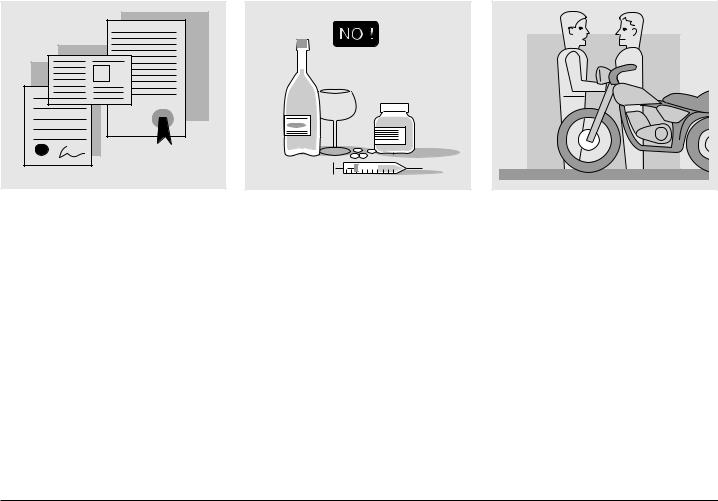
BASIC SAFETY RULES
To drive the vehicle it is necessary to be in possession of all the requirements prescribed by law (driving licence, minimum age, psychophysical ability, insurance, state taxes, vehicle registration, number plate, etc.).
Gradually get to know the vehicle by driving it first in areas with low traffic and/or private areas.
The use of medicins, alcohol and drugs or psychotropic substances notably increases the risk of accidents.
Be sure that you are in good psychophysical conditions and fit for driving and pay particular attention to physical weariness and drowsiness.
Most road accidents are caused by the driver’s lack of experience.
NEVER lend the vehicle to beginners and, in any case, make sure that the driver has all the requirements for driving.
6 |
use and maintenance Sonic 50 |
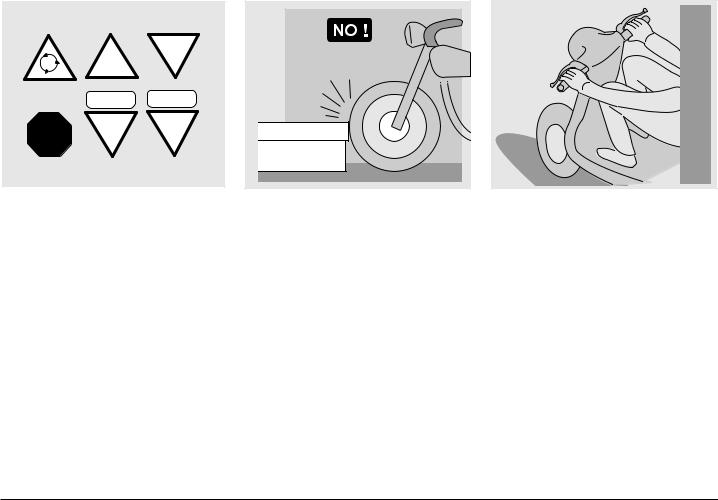
°
STOP 150 m 150 m
STOP
Rigorously observe all road signs and national and local road regulations.
Avoid abrupt movements that can be dangerous for yourself and other people (for example: rearing up on the back wheel, speeding, etc.), and give due consideration to the road surface, visibility and other driving conditions.
Avoid obstacles that could damage the vehicle or make you lose control.
Avoid riding in the slipstream created by preceding vehicles in order to increase your speed.
Always drive with both hands on the handlebars and both feet on the footrests, in the correct driving posture.
Avoid standing up or stretching your limbs while driving.
use and maintenance Sonic 50 |
7 |
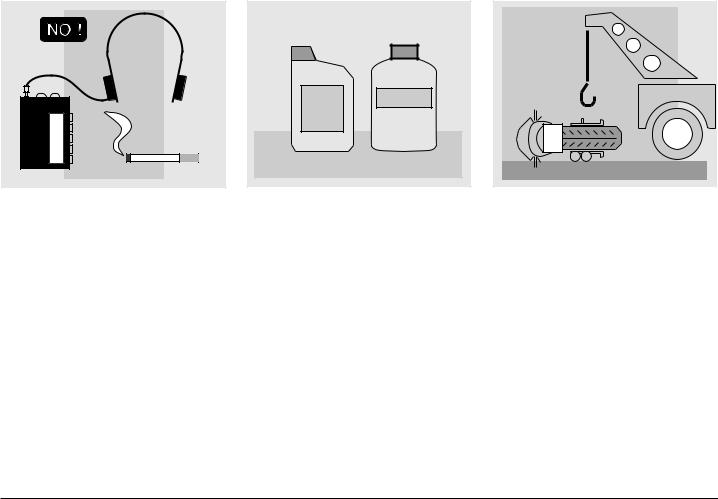
The driver should pay attention and avoid distractions caused by people, things and movements (never smoke, eat, drink, read, etc.) while driving.
COOLER |
OIL |
Use only the vehicle’s specific fuels and lubricants (indicated in the “LUBRICANT CHART”); check all oil, fuel and coolant levels regularly.
If the vehicle has been involved in an accident, make sure that no damage has occurred to the control levers, pipes, wires, braking system and vital parts.
If necessary, have the vehicle inspected by an aprilia Official Dealer, who should carefully check the frame, handlebars, suspensions, safety parts and all the devices that you cannot check by yourself.
Always remember to report any malfunction to the technicians to help them in their work.
Never use the vehicle when the amount of damage it has suffered endangers your safety.
8 |
use and maintenance Sonic 50 |
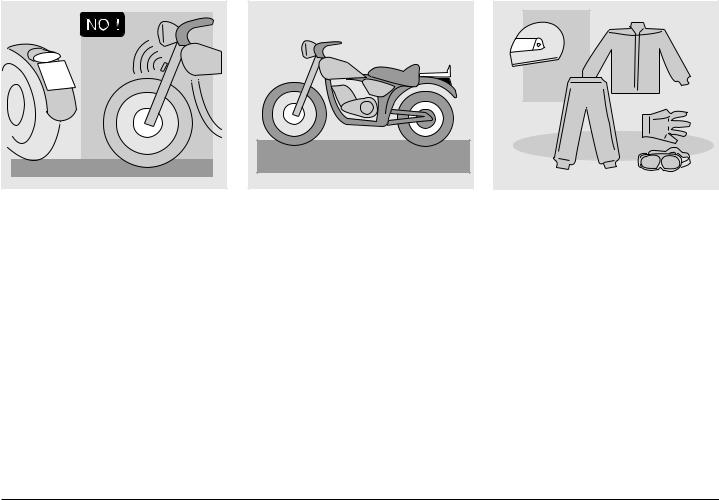
A12 |
345 |
Never change the position, inclination or colour of: number plate, direction indicators, lights and horns.
Any modification of the vehicle will result in the invalidity of the guarantee.
Any modification of the engine or of other members which is aimed at increasing the speed or the power of the vehicle is prohibited by the law; in fact, any modification resulting in an increase of the maximum speed or of the engine displacement would change the scooter into a motorcycle, which implies the following obligations for the owner:
–new homologation;
–new registration;
–appropriate driving license.
ONLY ORIGINALS
Further, said modifications cause the loss of the insurance cover, since insurance policies expressly prohibit to make technical changes aimed at increasing the vehicle performance levels.
For the reasons stated above, the failure to comply with the tampering prohibition is punished by law with apposite sanctions (including the confiscation of the vehicle), which, according to the case, can be combined with the sanctions provided for not using the crash helmet and/or the number plate, for the violation of fiscal obligations (ownership tax) and with penal sanctions provided for using the vehicle without driving license.
Never race with other vehicles.
Avoid off-road driving.
CLOTHING |
Before starting, always wear a correctly fastened crash helmet. Make sure that it is homologated, in good shape, of the right size and that the visor is clean.
Wear protective clothing, preferably in light and/or reflecting colours. In this way you will make yourself more visible to the other drivers, thus notably reducing the risk of being knocked down, and you will be more protected in case of fall. This clothing should be very tight-fitting and fastened at the wrists and ankles. Strings, belts and ties should not be hanging loose; prevent these and other objects from interfering with driving by getting entangled with moving parts or driving mechanisms.
use and maintenance Sonic 50 |
9 |
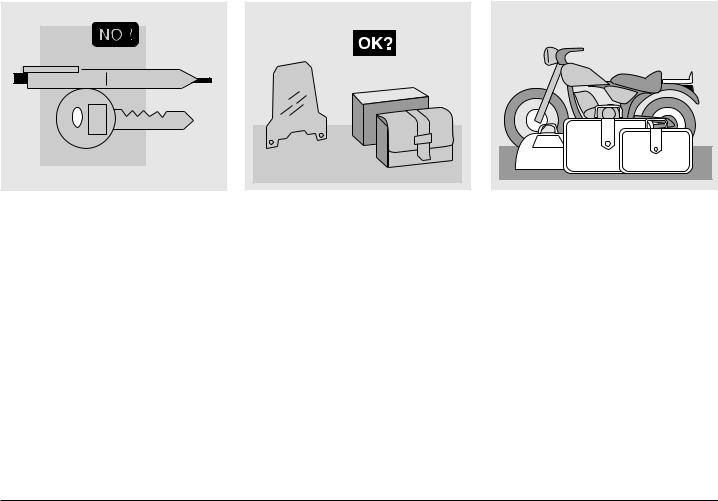
Do not keep objects that can be dangerous in case of fall, for example pointed objects like keys, pens, glass vials etc. in your pockets (the same recommendations also apply to passengers).
ACCESSORIES
The owner of the vehicle is responsible for the choice, installation and use of any accessory.
Avoid installing accessories that cover horns or lights or that could impair their functions, limit the suspension stroke and the steering angle, hamper the operation of the controls and reduce the distance from the ground and the angle of inclination in turns. Avoid using accessories that hamper access to the controls, since this can prolong reaction times during an emergency. Large fairings and windscreens assembled on the vehicle can produce aerodynamic forces capable of compromising the stability of the vehicle while driving. Make sure that the equipment is well fastened to the vehicle and not dangerous during driving.
Do not install electrical devices and do not modify those already existing to avoid electrical overloads, because the vehicle could suddenly stop or there could be a dangerous current shortage in the horn and in the lights. aprilia recommends the use of “aprilia genuine accessories”.
LOAD
Be careful and moderate when loading your luggage. Keep any luggage loaded as close as possible to the centre of the vehicle and distribute the load uniformly on both sides, in order to reduce imbalance to the minimum. Furthermore, make sure that the load is firmly secured to the vehicle, especially during long trips.
10 use and maintenance Sonic 50
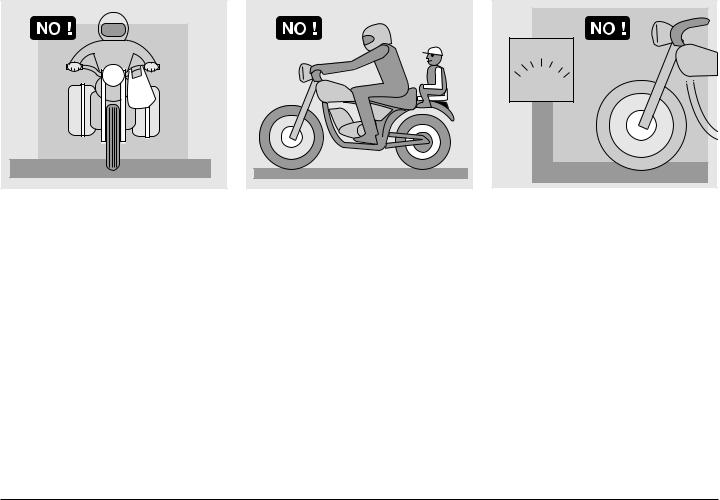
KG! |
Avoid hanging bulky, heavy and/or dangerous objects on the handlebars, mudguards and forks, because the vehicle might respond more slowly in turns and its manoeuvrability could be unavoidably impaired.
Do not place bags that are too bulky on the vehicle sides, because it could hit people or obstacles making you lose control of the vehicle.
Do not carry any bag if it is not tightly secured to the vehicle.
Do not carry bags which protrude too much from the luggage-rack or which cover the lights, horn or indicators.
Do not carry animals or children on the glove compartment or on the luggage-rack.
Do not exceed the maximum load allowed for each side-bag.
When the vehicle is overloaded, its stability and its manoeuvrability can be compromised.
use and maintenance Sonic 50 11

ARRANGEMENT OF THE MAIN ELEMENTS
|
|
|
|
|
KEY |
|
|
||
1) |
Bag hook |
7) |
Transmission oil drain plug |
|
2) |
Fuel tank |
8) |
Centre stand |
|
3) |
Fuel tank plug |
9) |
Air cleaner |
|
4) |
Saddle lock |
10) |
Side stand & |
|
5) |
Transmission oil filling cap |
11) |
Horn |
|
6) |
Kick starter |
|
|
|
12 use and maintenance Sonic 50
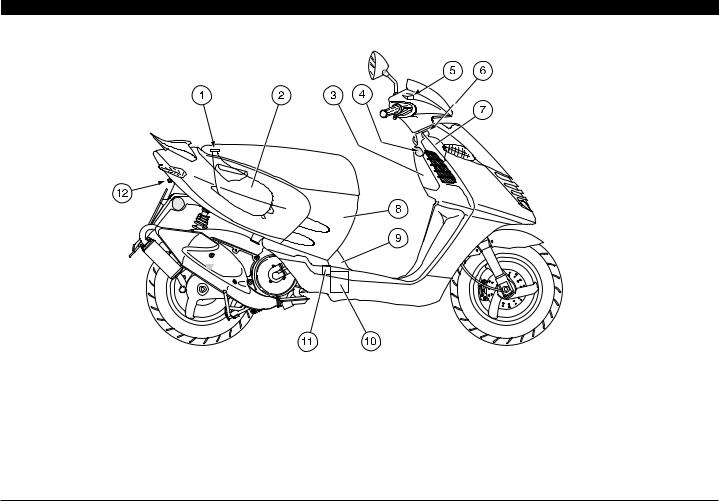
|
|
|
|
|
|
|
|
|
|
|
|
|
|
|
|
|
|
|
|
|
|
|
|
|
|
|
|
|
|
|
|
|
|
|
|
|
|
|
|
|
|
|
|
|
|
|
|
|
|
|
|
|
|
|
|
|
|
|
|
KEY |
|
|
|
|
|||||
1) |
2 stroke oil tank plug |
8) |
Front cover of the rear part of the fairing |
||||||
2) |
2 stroke oil tank |
9) |
Inspection cover |
||||||
3) |
Glove compartment |
10) |
Battery |
||||||
4) |
Ignition switch/steering lock |
11) |
Fuse carrier |
||||||
5) |
Brake fluid reservoir (front brake) |
12) |
Anti-theft hook (for the aprilia “Body- |
||||||
6) |
Coolant expansion tank plug 1 |
|
|
Guard” armored cable &). |
|||||
7) |
Expansion tank |
|
|
|
|
||||
use and maintenance Sonic 50 13
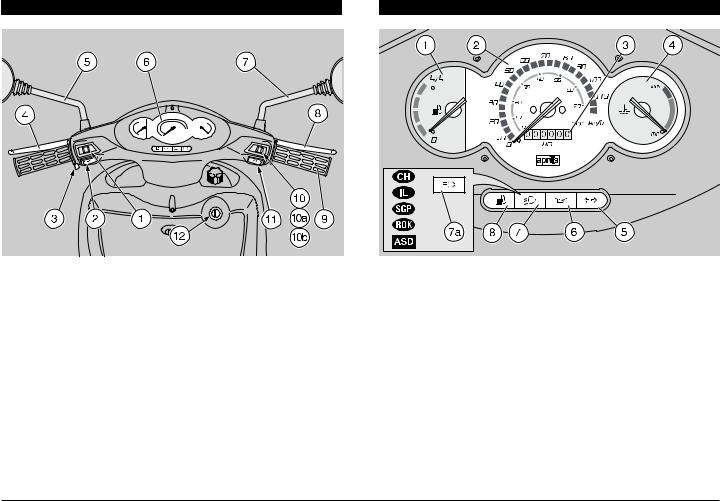
ARRANGEMENT OF THE INSTRUMENTS
KEY
1) Direction indicator switch (c)
2) Horn push button (f)
3) Cold start lever (e)
4) Rear brake lever
5) Left rear-view mirror (not provided in the Uversion) 6) Instruments and indicators
7) Right rear-view mirror (in the countries where required) 8) Front brake lever
9) Throttle grip
10) Headlight switch (b - •)
10a) Headlight switch (a - b - •) C%SK 10b) Headlight dimmer switch (a - b) _
11)Start push button (r)
12)Ignition switch/steering lock (n - m - s)
INSTRUMENTS AND INDICATORS
KEY
1) Fuel level indicator (g)
2) Speedometer
3) Total kilometres odometer
4) Coolant temperature indicator (h) 1
5) Green direction indicator warning light (c) 6) Red 2 stroke oil reserve warning light (j) 7) Green low beam warning light (b)
7a) Blue high beam warning light (a) C%SK_ 8) Amber low fuel warning light (g)
14 use and maintenance Sonic 50

INSTRUMENT AND INDICATOR TABLE
Description |
|
Function |
|
|
|
Direction indicator warning light |
(c) |
It blinks when the direction indicators are on. |
|
|
|
|
|
It comes on when the ignition switch is in position “n” and the start push button |
|
|
“r“ is pressed, thus checking the proper functioning of the bulb. |
|
|
If the light does not come on during the starting, provide for replacing the bulb. |
2 stroke oil reserve warning light |
(j) |
If the warning light comes on and does not go out after the start |
|
|
push button “ r” has been released, or if it comes on during nor- |
|
|
amal functioning, this means that the 2 stroke oil reserve is being |
|
|
used; in this case, top up the 2 stroke oil tank, see p. 22 (2 STROKE OIL |
|
|
TANK). |
|
|
|
Total kilometres odometer |
|
It indicates the total number of kilometres covered. |
|
|
|
Speedometer |
|
It indicates the driving speed. |
|
|
|
Low beam warning light |
(b) |
It comes on when the headlight is in low beam position. |
|
|
|
High beam warning light |
|
It comes on when the headlight in high beam position. |
C%SK_ |
(a) |
|
|
|
|
Low fuel warning light |
(g) |
It comes on when the quantity of fuel left in the tank is about 1,5 l. |
|
|
|
Fuel level indicator |
(g) |
It indicates the approximate fuel level in the tank. |
|
|
|
|
|
It indicates the approximate temperature of the coolant in the engine. |
|
|
When the pointer starts moving beyond the “min” level, the temperature is suffi- |
|
|
cient for driving the vehicle. |
Coolant temperature indicator 1 |
(h) |
The normal running temperature range is indicated by the central area of the |
scale. |
||
|
|
If the pointer reaches the red area, stop the engine and check the coolant level, |
|
|
see p. 26 (COOLANT 1). |
|
|
If the maximum allowed temperature is exceeded (red area “max” |
|
|
aof the scale), the engine may be seriously damaged. |
use and maintenance Sonic 50 15
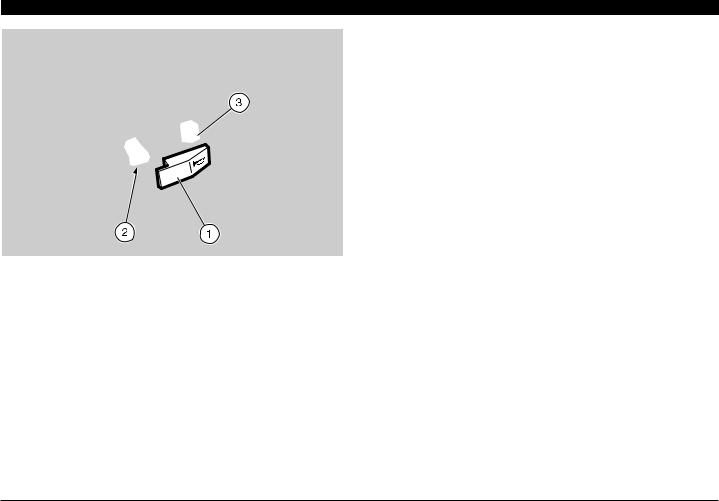
MAIN INDEPENDENT CONTROLS
CONTROLS ON THE LEFT SIDE OF THE HANDLEBAR
cThe electrical parts work only when the ignition switch is in position “ n”.
cTherunning.lighting system works only when the engine is
1) HORN PUSH BUTTON (f)
The horn is activated when the push button is pressed.
2) COLD START LEVER (e)
The starter for the cold start of the engine is operated by rotating the lever downwards.
To disconnect the cold start, bring the lever to its initial position.
3) DIRECTION INDICATOR SWITCH (c)
To indicate the turn to the left, move the switch to the left; to indicate the turn to the right, move the switch to the right.
To turn off the direction indicator, press the switch.
16 use and maintenance Sonic 50

CONTROLS ON THE RIGHT SIDE OF THE HANDLEBAR
cThe electrical parts work only when the ignition switch is in position “ n”.
cTherunning.lighting system works only when the engine is
1)LIGHT SWITCH (b - •)
When the light switch is in position “•”, the lights are off; when the switch is in position “b”, the rear parking light and the low beam are on.
1a) LIGHT SWITCH (a - b - •) C%SK
When the light switch is in position “•”, the lights are off; when the switch is in position “b” the low beam and the parking lights are on; when it is in position “a” the high beam and the parking lights are on.
1b) DIMMER SWITCH ( a - b) _
When the dimmer switch is in position “b”, the low beam and the parking lights are on; when it is in position “a”, the high beam and the parking lights are on.
cThethe engine.lights can be switched off only by stopping
2)START PUSH BUTTON (r)
When the start push button is pressed and one of the brake levers (front or rear) is activated at the same time, the starter makes the engine run.
For the starting procedure, see p. 30 (STARTING).
use and maintenance Sonic 50 17
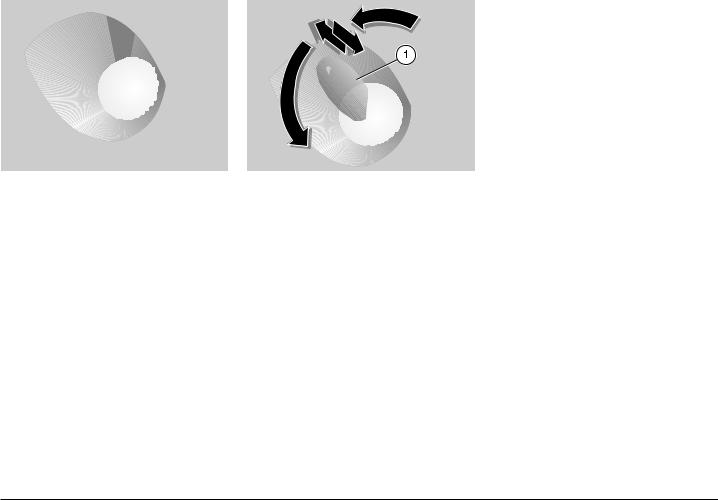
IGNITION SWITCH
The ignition switch is positioned on the right side, near the steering column.
cThe key (1) operates the ignition switch/steering lock, glove com-
partment and the saddle lock.
Two keys are supplied together with the vehicle (one spare key).
STEERING LOCK
Never turn the key to position “ s” in running conditions, in order to avoid losing control of the vehicle.
OPERATION
To lock the steering:
Turn the handlebar completely leftwards.
Turn the key (1) to position “m” and press it.
Release the key.
cTurn the key and steer the handlebar at the same time.
Rotate the key (1) anticlockwise (left-
wards), steer the handlebar slowly until the key (1) reaches position “s”.
Extract the key.
Position |
Function |
Key |
|
removal |
|||
|
|
||
|
|
|
|
s |
The steering |
It is possible |
|
is locked. |
to remove |
||
It is neither |
the key. |
||
|
possible to |
|
|
Steering |
start the en- |
|
|
lock |
gine, nor to |
|
|
|
switch on the |
|
|
|
lights. |
|
|
|
|
|
|
|
Neither the |
It is possible |
|
m |
engine, nor |
to remove |
|
the lights can |
the key. |
||
|
be switched |
|
|
|
on. |
|
|
|
|
|
|
n |
The engine |
It is not pos- |
|
and the lights |
sible to re- |
||
can be |
move the |
||
|
switched on. |
key. |
|
|
|
|
18 use and maintenance Sonic 50
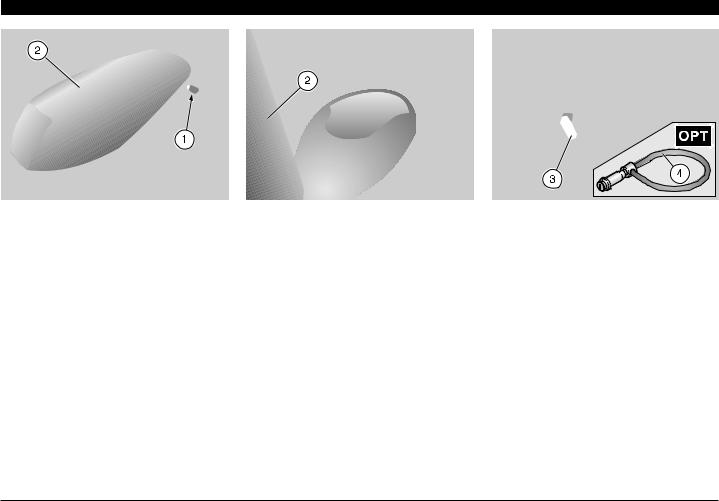
AUXILIARY EQUIPMENT
UNLOCKING/LOCKING
THE SADDLE
To unlock and lift the saddle:
Insert the key in the saddle lock (1).
Turn the key clockwise and raise the saddle (2).
cBefore lowering and locking the saddle, make sure that you have not left the key in the crash hel -
met/glove compartment.
To lock the saddle, lower and press it (without exerting too much pressure), thus making the lock snap shut.
aBefore leaving, make sure that the saddle is properly locked.
CRASH HELMET / GLOVE
COMPARTMENT
Thanks to the crash helmet/glove compartment, you no longer have to carry the crash helmet or other objects with you every time you park the vehicle.
The compartment is positioned under the saddle.
To reach it:
Raise the saddle, see beside (UNLOCKING/LOCKING THE SADDLE).
cPosition the helmet with the opening facing upwards, as
shown in the figure.
aDo n o t l o a d t h e c r a s h h e l - met/glove compartment too much.
Maximum allowed weight: 2.5 kg.
ANTI-THEFT HOOK
The anti-theft hook (3) is positioned on the rear side of the vehicle, near the rear light.
To prevent the vehicle from being stolen, it is advisable to secure it with the aprilia “Body-Guard” armored cable &(4), available at any aprilia Official Dealer.
aDo not use the hook to lift the vehicle or for any purpose other than securing the vehicle once it
has been parked.
use and maintenance Sonic 50 19
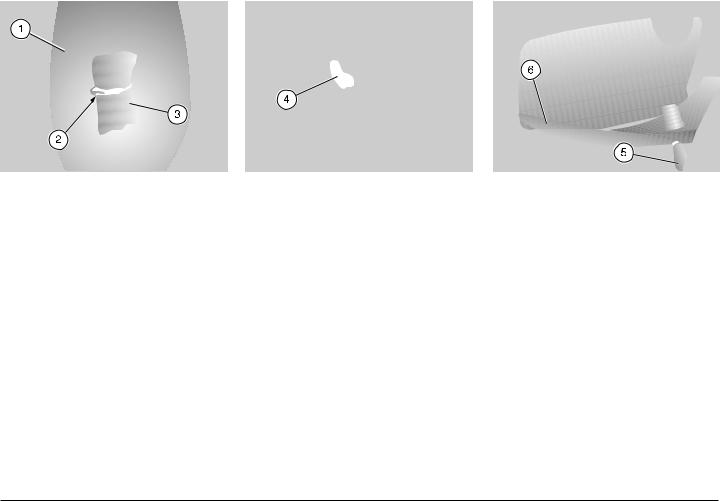
TOOL KIT
The tool kit is hooked to the underside of the saddle.
To reach it, proceed as follows:
Lift the saddle (1), see p. 19 (UNLOCKING/LOCKING THE SADDLE).
Release the rubber band (2) from the hook.
Take the tool kit (3).
The tool kit (3) includes:
–n. 1 tool case
–n. 1 21 mm spark plug socket spanner
–n. 1 socket spanner rod
–n. 1 8/10 mm socket spanner
–n. 1 double-ended, cross-/cut headedscrewdriver type PH size 2
–n. 1 screwdriver handle
–n. 1 3 mm hexagon spanner
–n. 1 4 mm hexagon spanner
Maximum allowed weight: 1.5 kg.
BAG HOOK
aDo not hang excessively bulky bags or parcels to the hook, as this may seriously compromise
the manoeuvrability of the vehicle or the movement of your feet.
The bag hook (4) is positioned on the front part of the inner shield.
Max. allowed weight: 1.5 kg.
GLOVE COMPARTMENT
It is placed under the handlebar, on the inner part of the shield.
To reach it:
Introduce the ignition key (5) in the lock.
Turn the key clockwise, pull it and open the door (6).
aBefore locking the door, make sure that you have not left the key in the glove compartment.
To lock the door (6), raise and press it. It is not necessary to use the key.
Maximum allowed weight: 1.5 kg.
20 use and maintenance Sonic 50

MAIN COMPONENTS
FUEL
aThe fuel used for internal combustion engines is extremely inflammable and in particular con-
ditions it can become explosive.
It is important to carry out the refuelling and the maintenance operations in a well-ventilated area, with the engine off.
Do not smoke while refuelling or near fuel vapours, in any case avoid any contact with naked flames, sparks and any other heat source to prevent the fuel from catching fire or from exploding.
Further, prevent fuel from flowing out of the fuel filler, as it could catch fire when getting in contact with the red-hot surfaces of the engine.
In case some fuel has accidentally been spilt, make sure that the area has completely dried and before starting the vehicle verify that there is no fuel inside the fuel filler neck.
Since petrol expands under the heat of the sun and due to the effects of sun radiation, never fill the tank to the brim.
Screw the plug (1) up carefully after refuelling.
Avoid any contact of the fuel with the skin and the inhalation of vapours; do not swallow fuel or pour it from a receptacle into another by means of a tube.
KEEP AWAY FROM CHILDREN
Use only premium grade petrol (4 Stars U), in conformity with the DIN 51600 standard, min. O.N. 98 (N.O.R.M.) and 88 (N.O.M.M.).
2Use only unleaded petrol, in conformity with the DIN 51607 standard, min. O.N. 95 (N.O.R.M.) and 85 (N.O.M.M.).
FUEL TANK CAPACITY (reserve included): 8 l
TANK RESERVE: 1.5 l
To refuel, proceed as follows:
Lift the saddle, see p. 19 (UNLOCKING/LOCKING THE SADDLE).
Unscrew and remove the fuel tank plug
(1).
Refuel.
use and maintenance Sonic 50 21

2 STROKE OIL TANK
Top up the 2 stroke oil tank every 500 km.
The vehicle is provided with a separate mixer that makes it possible to mix petrol with oil for the lubrication of the engine, see p. 70 (LUBRICANT CHART).
The reserve is indicated by the coming on of the 2 stroke oil reserve warning light “j” positioned on the dashboard, see p. 14 and 15 (INSTRUMENTS AND INDICATORS).
aThe use of the vehicle without 2 stroke oil causes serious damages to the engine.
If you run out of oil in the 2 stroke oil tank or if the mixer oil pipe has been removed, it is necessary to contact an aprilia Official Dealer, who will provide for bleeding the system.
This operation is indispensable, since the operation of the engine with air in the mixer oil system may cause serious damages to the engine itself.
To top up the 2 stroke oil tank, proceed as follows:
Lift the saddle, see p. 19 (UNLOCKING/LOCKING THE SADDLE).
Remove the plug (1).
2 STROKE OIL TANK CAPACITY: 1.6 l
TANK RESERVE: 0.5 l
aWash your hands carefully after using the oil.
Do not dispose of the oil in the environment.
KEEP AWAY FROM CHILDREN.
BRAKE FLUID - recommendations
aSudden resistance or clearance problems on the brake lever may be due to problems in the hy-
draulic system.
For any doubt regarding the perfect functioning of the braking system and in case you are not able to carry out the usual checking operations, contact your aprilia Official Dealer.
Make sure that the brake disc and the friction elements are neither oily nor greasy, especially after maintenance or checking operations.
Check that the brake cable is neither twisted nor worn out.
Prevent water or dust from accidentally getting into the circuit.
In case maintenance operations are to be performed on the hydraulic circuit, it is advisable to use latex gloves.
If the brake fluid gets in contact with the skin or the eyes, it can cause serious irritations.
Carefully wash the parts of your body that get in contact with the liquid. Consult a doctor or an oculist if the liquid gets in contact with your eyes.
Do not dispose of the brake fluid in the environment.
KEEP AWAY FROM CHILDREN
aWhen using the brake fluid, take care not to spill it on the plastic or painted parts, since it irrepa-
rably damages them.
22 use and maintenance Sonic 50
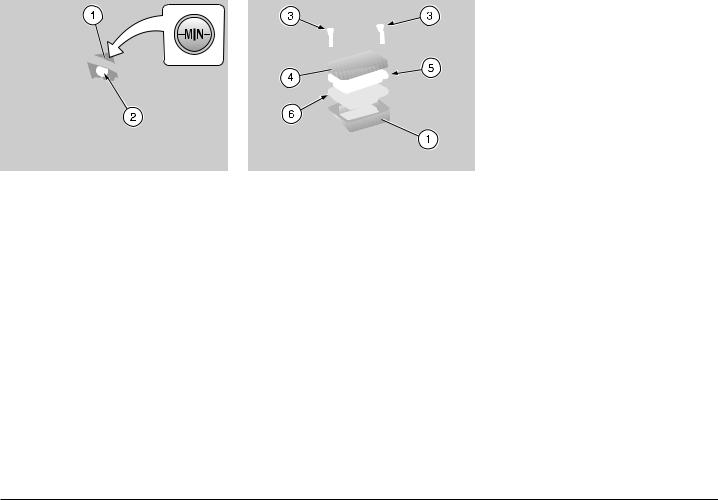
FRONT BRAKE DISC
aThe brakes are the parts that most ensure your safety and for this reason they must always be
perfectly working.
The brake fluid must be changed once a year by an aprilia Official Dealer.
This vehicle is provided with front hydraulic disc brake.
When the disc pads wear out, the level of the fluid decreases to automatically compensate for their wear.
The brake fluid reservoir (1) is positioned near the front brake lever coupling. Periodically check the brake fluid level in the reservoir (1) and the pad wear, see p. 43 (CHECKING THE BRAKE PAD WEAR).
CHECKING
To check the brake fluid level, proceed as follows:
Position the vehicle on the centre stand.
Rotate the handlebar leftwards, so that the fluid contained in the reservoir is parallel to the “MIN” mark stamped on the glass (2).
Make sure that the level of the brake fluid contained in the tank exceeds the “MIN” mark stamped on the glass (2).
If not, provide for topping up.
TOPPING UP
Carefully read p. 22 (BRAKE FLUID - recommendations).
aThe brake fluid may flow out of the reservoir. Do not operate the brake lever if the screws (3) are
loose or, most important, if the brake fluid tank cover has been removed.
Unscrew the two screws (3).
Remove the cover (4).
Remove the guide cover (5).
aIn order not to spill the brake fluid while topping up, keep the fluid in the reservoir parallel to the reser-
voir rim.
Remove the gasket (6).
cIn order to reach the “MAX” level, top up until covering the glass
(2) completely, with the brake fluid reservoir rim parallel to the ground.
aThe topping up to the “MAX” level can be carried out only with new pads.
The fluid level decreases progressively with the pad wear.
Do not top up to the “MAX” level with worn pads, since this may cause an outflow of liquid when the brake pads are changed.
Fill the tank with brake fluid, see p. 70 (LUBRICANT CHART), until it covers the glass completely.
Put back the gasket (6) in its seat correctly.
Put back the guide cover (5) correctly.
Put back the cover (4).
Screw and tighten the two screws (3).
use and maintenance Sonic 50 23
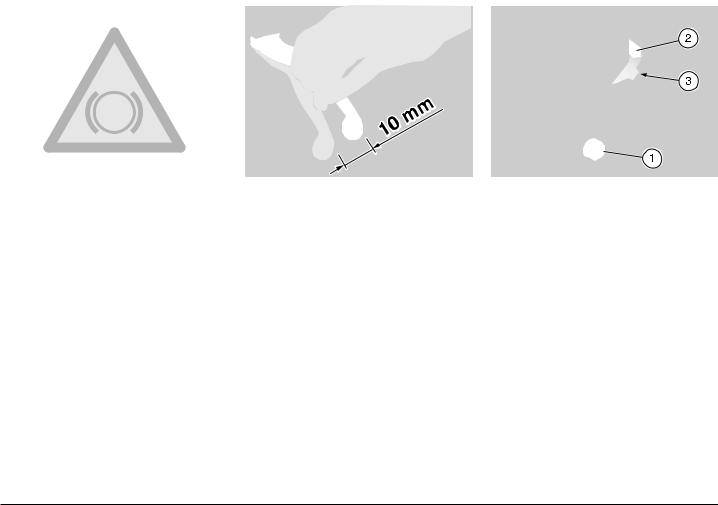
aCheck the braking efficiency. If necessary, contact your aprilia Official Dealer.
In case of excessive movement of the brake lever, of excessive elasticity or in case there is air in the circuit, contact your aprilia Official Dealer, since it may be necessary to bleed the system.
REAR DRUM BRAKE
aThe brakes are the parts that most ensure your safety and for this reason they must always be
perfectly working.
For any doubt regarding the perfect functioning of the braking system and in case you are not able to carry out the usual checking operations, contact your aprilia Official Dealer.
ADJUSTING THE BRAKE
Measure the distance covered by the lever before the brake starts it braking action. The idle stroke at the end of the brake lever must be about 10 mm.
Adjust the clearance by acting on the adjuster (1).
Put on the brake repeatedly and make sure that the wheel turns freely after the brake has been released.
Check the braking efficiency.
The fact that the adjuster (1) can be tightened completely or the indicator (2) is positioned beyond the reference tooth (3) indicates that the brake shoes a r e w o r n ; i n t h i s c a s e , s e e p . 4 4 (CHECKING THE SHOE WEAR).
24 use and maintenance Sonic 50
